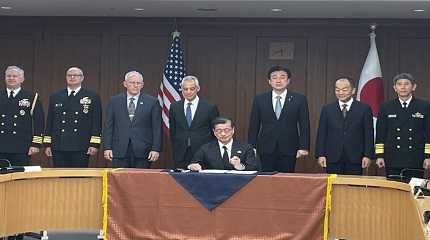
TOKYO (AP) — Japan signed a deal with the United States on Thursday to purchase up to 400 Tomahawk cruise missiles as part of its ongoing military buildup in response to increased regional threats.
Prime Minister Fumio Kishida’s government has pledged to double its annual defense spending to around 10 trillion yen ($68 billion) by 2027, which would make Japan the world’s third-biggest military spender after the United States and China.
Defense Minister Minoru Kihara announced in December a decision to accelerate deployment of some Tomahawks and Japanese-made Type 12 surface-to-ship missiles beginning in fiscal year 2025, a year before the original plan. The government says Japan is facing its “severest” security environment since World War II because of threats from China and North Korea, causing it to increase military cooperation with the U.S., Australia, Britain and other friendly nations.
In November, the U.S. approved a $2.35 billion sale of two types of Tomahawks — 200 Block IV missiles and 200 upgraded Block V versions. They can be launched from warships and hit targets 1,600 kilometers (1,000 miles) away, officials said.
The signing of the purchase agreement on Thursday was attended by Kihara and U.S. Ambassador to Japan Rahm Emanuel.
Japan and the United States agreed to expedite the deployment “in response to the increasingly severe security environment,” Kihara said.
Emanuel said training of Japanese servicemembers for the Tomahawks will start in March.
Late last year, Japan’s Cabinet eased a ban on exports of lethal weapons, allowing the sale of Japanese-made weapons and components made under license from other nations to those countries. The government quickly approved a shipment of Japanese-made Patriot missiles to the United States to complement the U.S. inventory.
Japan is accelerating its deployment of long-range cruise missiles capable of hitting targets in China or North Korea, while Japanese troops increasingly work side-by-side with the U.S. and other friendly nations and take on more offensive roles.
At a news conference earlier Thursday marking the end of his second year in Tokyo, Emanuel lauded Japan’s rapid move during that time to build up its military and strengthen its alliance with the U.S. to meet challenges in the region.
Under a new defense strategy adopted in December 2022, Japan has joined the United States, Australia, South Korea and many other regional partners “in an aligned vision of how to promote peace and prosperity in the Indo-Pacific and meet the challenges head on,” Emanuel said.
The U.S. approach to its partnership with Japan is “one of ensuring deterrence” and making sure there is no change in the region by military force, Emanuel said.
“There is a new Japan emerging, a more competent Japan,” he said.




